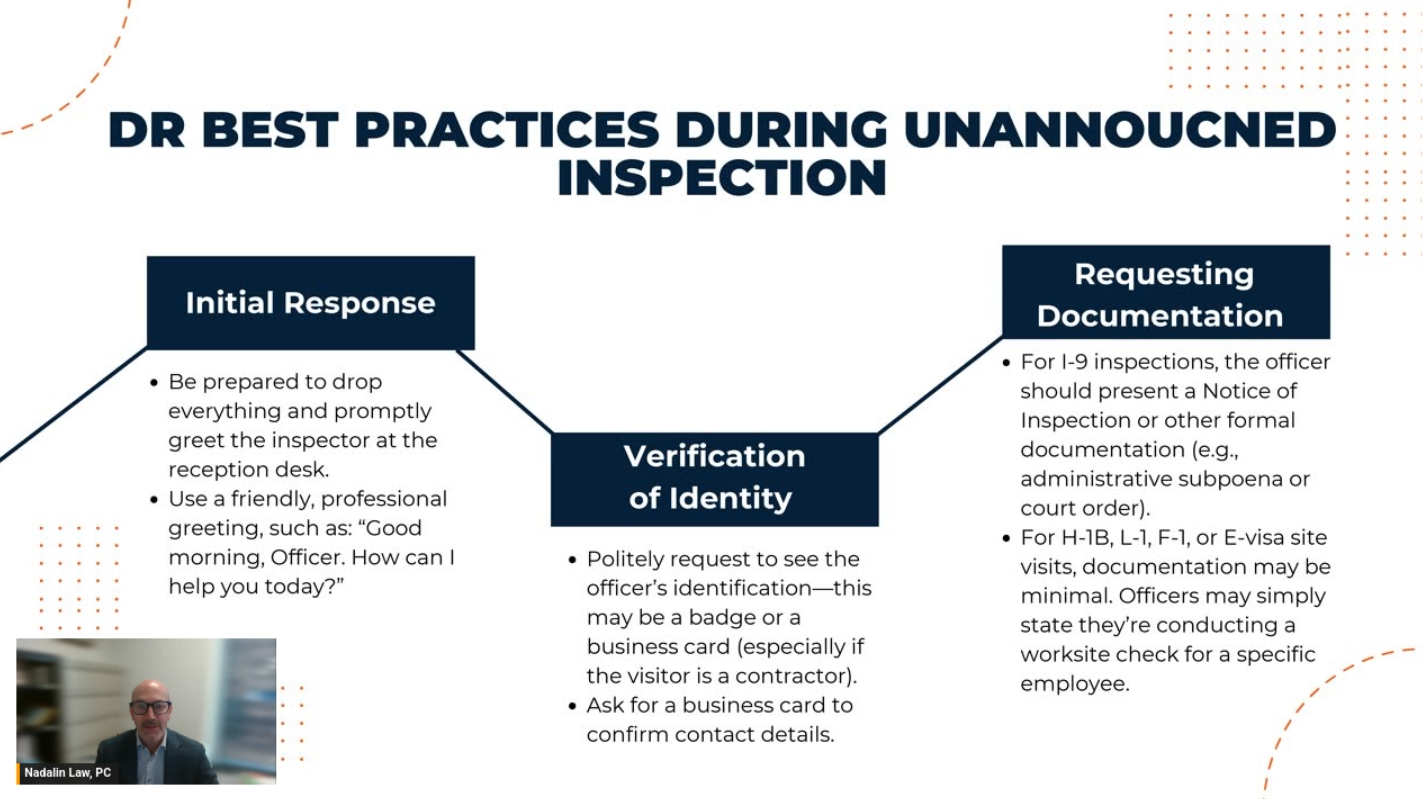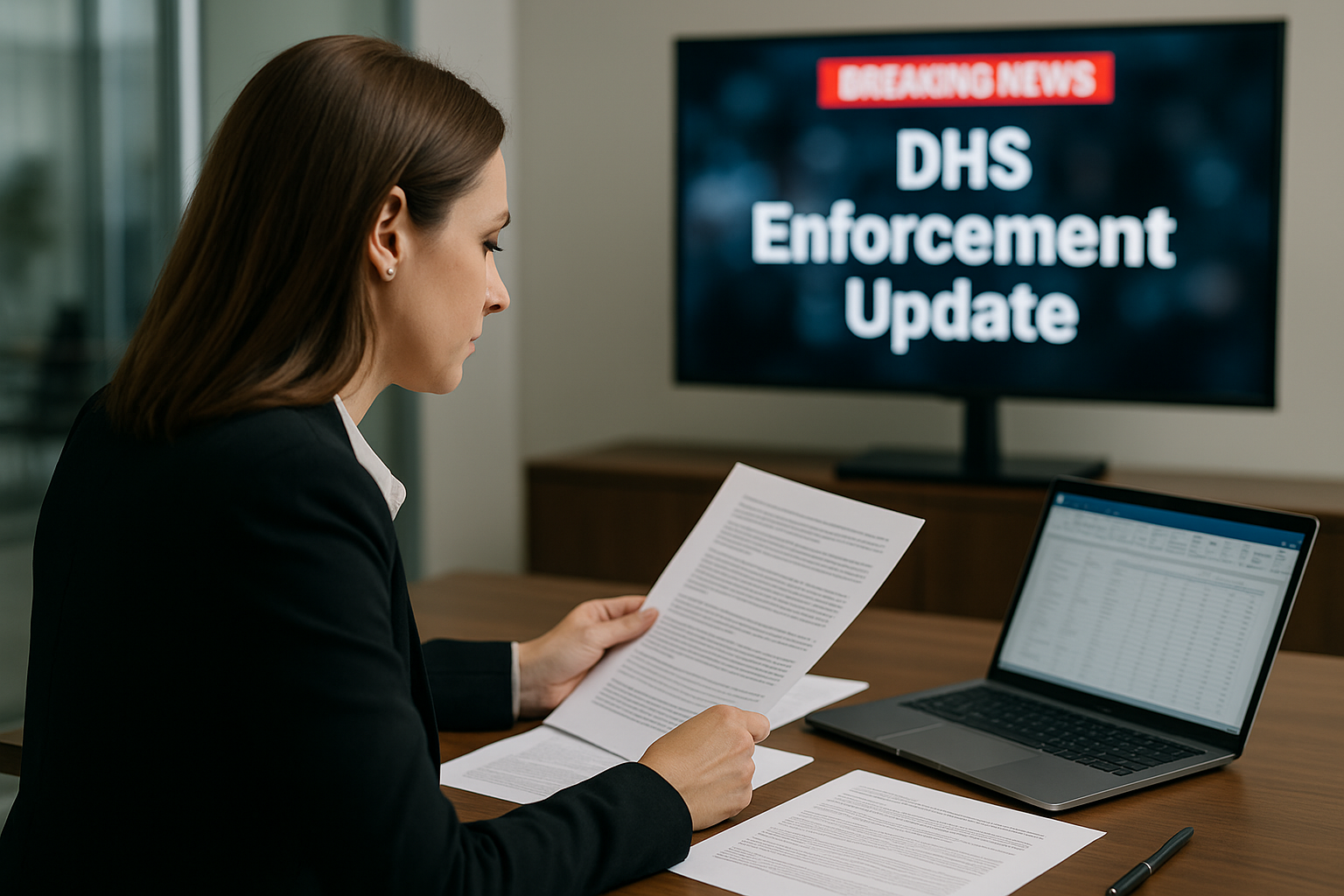If you manage immigration cases for your company, you’ve probably seen the headlines about the Hyundai-LG battery plant raid in Georgia—where 500 workers were detained.
For many HR and Legal Ops teams, it raised the same question: Could this happen to us?
While most companies won’t find themselves in a DHS enforcement raid, the incident signals a shift. The government is increasing scrutiny of how employers use visa programs—and whether they’re stretching the rules a little too far.
Here’s what HR leaders should know and do right now to protect their organizations and employees.
1. Know Where You Stand on the “Risk Spectrum”
Every company fits somewhere on what attorney Robert Nadalin calls the immigration compliance risk spectrum:
| Risk Level | Company Profile | Why It Matters |
| Low Risk | Uses standard H-1B, L-1, or E visas with full documentation and regular legal review. | You’re likely compliant, but should still verify recordkeeping and reporting procedures annually. |
| Moderate Risk | May occasionally rely on gray-area guidance, exceptions, or administrative opinion letters to justify visa eligibility. | These interpretations can become stale—what was acceptable in prior years ago may now trigger additional government review. |
| High Risk | Relies on aggressive interpretations of the law, including relying heavily on visitor visas (B-1/B-2) or after-sale service exceptions for work in the U.S., temporary programs, non-employee contractors. | This is the category DHS is targeting most aggressively, as seen in recent enforcement cases. |
Takeaway: Don’t panic with the ebb and flow of the news cycle, but do know where your company sits on the risk spectrum. The best defense is to proactively review compliance procedures and documentation.
2. Reassess Your Visa Programs and Documentation
If your organization has multiple visa holders, especially in L-1A, H-1B, or E categories, it’s time for a quick self-audit:
✓ Are you strictly adhering to visa terms—especially regarding job duties and H-1B work location limitations?
✓ Are all visa records, petitions, and employee files organized and current?
✓ Do your third-party vendors or foreign affiliates understand the limitations of the visitor visa?
Even well-intentioned companies can get caught off guard when small procedural oversights accumulate. A short internal review with your immigration counsel can prevent major disruption later.
3. Understand the New DHS Trend: Notices to Appear (NTAs)
Another development catching HR teams by surprise: laid-off foreign workers receiving DHS “Notices to Appear” (NTAs)—formal notices to attend immigration court hearings.
Here’s what’s happening:
- When an H-1B employee is laid off, employers must notify USCIS.
- In some cases, that notification triggers a Notice to Appear from DHS.
- Even if the worker later finds new employment, an unresolved NTA can escalate into removal proceedings, and possibly a removal (aka “deportation”) order.
Stay ahead on immigration updates — join our newsletter →
What HR Should Do
- Notify the Company’s immigration legal counsel immediately if HR has knowledge that an employee or former employee has received an NTA.
- Track termination notifications carefully. Keep clear records of who was notified, when, and how.
- Communicate with affected employees—encourage them to seek personal immigration legal representation immediately. The Company’s attorney often cannot represent employees who have been placed in removal proceedings due to conflicts in the Company and employee’s separate interests. Ignoring an NTA can have severe long-term consequences.
4. Build a Compliance Culture—Not a Crisis Response
Immigration compliance shouldn’t live in a single spreadsheet or the hands of one HR manager. Create a rhythm of proactive oversight:
- Annual Immigration File Review: Verify that all I-9s, petitions, and supporting documents are accurate and accessible.
- Training for HR and managers: Violations can stem from well-meaning internal missteps—like moving H-1B employees to new and different job sites due to changing employer or customer needs without amending petition filings.
- Legal Check-Ins: Regularly touch base with your immigration counsel to stay updated on evolving interpretations and policies.
This approach can transform compliance from a reactive burden into a strategic business safeguard.
5. Prepare for the Next News Cycle Before It Hits
As Robert Nadalin reminds clients:
“Rather than have mass panic when you see a scary headline, know where you fit on the spectrum. Check with counsel before assuming the worst.”
The Hyundai-LG raid won’t be the last headline.
DHS has made clear it’s stepping up site visits, worksite audits, and enforcement actions—especially in manufacturing, tech, and biotech.
By identifying vulnerabilities now and confirming your processes, you’ll protect both your organization and the foreign professionals who keep it running.
What to Do When DR Appears For An Inspection

Quick Compliance Checklist for HR Leaders
✓ Map your company’s visa programs and identify any gray areas
✓ Verify that all employment locations and job titles match what’s on record
✓ Confirm timely USCIS notifications for layoffs or status changes
✓ Train HR staff on what triggers DHS notices or audits
✓ Keep legal counsel on standby for urgent questions
FAQ: DHS Enforcement and HR Compliance
1. What triggers a DHS site visit or raid?
Typically, red flags include visa misuse (e.g., working on visitor visas), inconsistent job descriptions, or whistleblower tips. Random audits can also occur under ongoing enforcement initiatives.
2. Are L-1A and E visa employees at risk?
Generally, no—if the company fully complies with visa terms. Most DHS actions target misuse of exceptions or expired status.
3. What happens if a foreign employee receives an NTA?
They must appear in immigration court. Employers should advise them to contact an immigration attorney immediately—leaving the U.S. without resolving the case can complicate future entries.
4. How often should we review immigration files?
At least annually, and any time the company expands operations, changes ownership, or restructures job roles.
5. What’s the best way to prepare HR teams for enforcement updates?
Subscribe to a reliable immigration law newsletter, conduct periodic compliance briefings, and establish a direct communication line with your immigration counsel.
Contact Nadalin Law to schedule a consultation or learn more by filling out the form below ↓
Get In Touch

Robert G. Nadalin is certified by the State Bar of California Board of Legal Specialization as a Specialist in Immigration and Nationality Law. He received his J.D. from South Texas College of Law in 1998 and his B.A. in Japanese from Ohio State University in 1993. Robert has served in leadership roles with the American Immigration Lawyers Association (AILA), including San Diego Chapter President, National Board Member, and California Service Center Liaison Committee Member. He is a member of the State Bar of California and the State Bar of Texas.



![Trump’s Proposed 100k H-1B Fee— Robert Nadalin Comments It [Video]](https://nadalinlaw.com/wp-content/uploads/2025/09/D5IX5OYFLZM5RIAFPONOA3I3OM-scaled-e1758647749127-500x383.avif)



